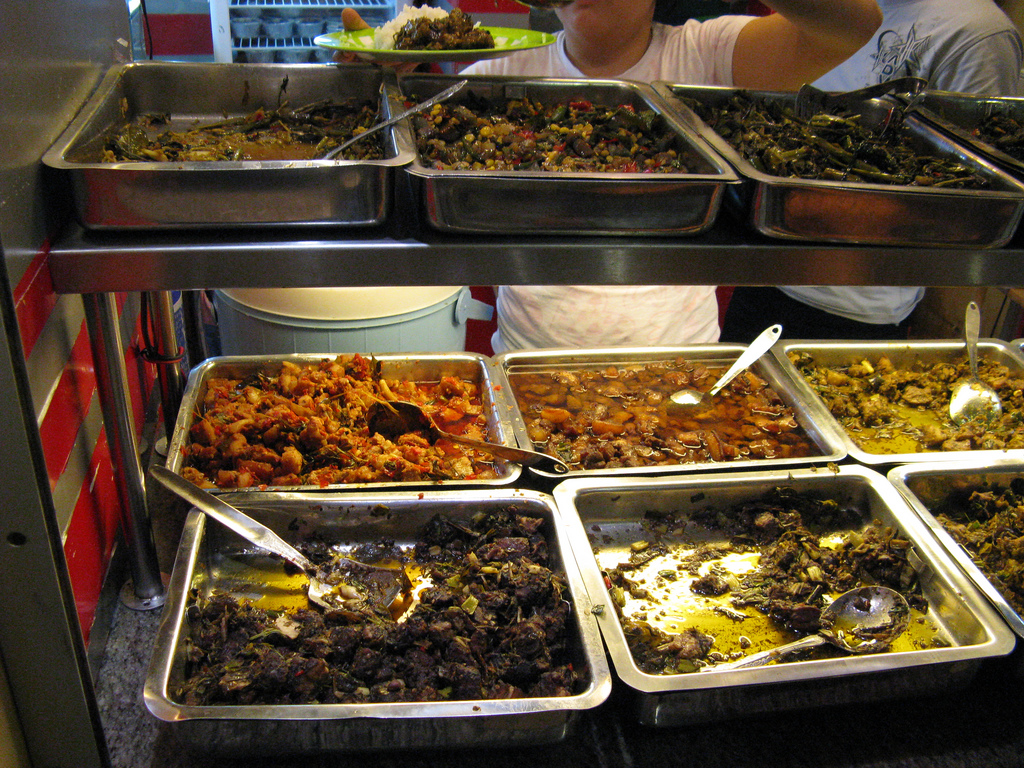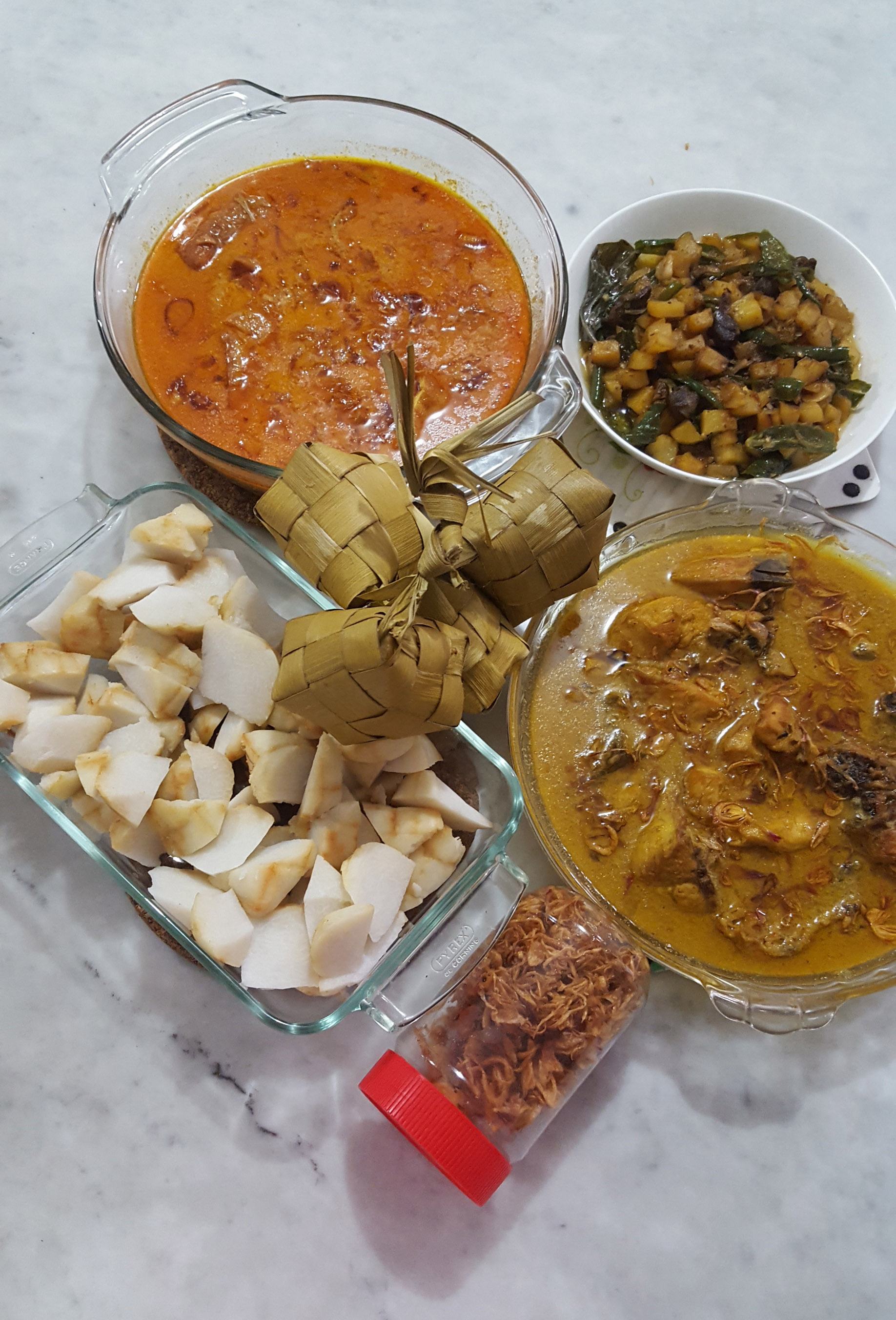|
Woku
Woku is an Indonesian type of ''bumbu'' (spice mixture) found in Manado cuisine of North Sulawesi, Indonesia, which usually used to prepare animal protein sources, e.g. fish and chicken. Preparation Woku consists of a ground spice paste made primarily of red ginger, turmeric, candlenut, and red chili pepper, mixed with chopped shallot, scallion, tomato, lemon or citrus leaf, and turmeric leaf, lemon basil leaf, and bruised lemongrass. The dish uses either chicken or fish that is briefly marinated in salt and lime juice before the spice paste is cooked in coconut oil. Once aromatic, the chicken or fish is mixed into the spice paste with water and a pinch of salt until cooked. Etymology Woku is an authentic Manado sauce that gets its name from '' daun woka'', a kind of young coconut leaf that is usually used as a rice wrapper. Originally, the initial woku dishes were all wrapped in young coconut or banana leaves before being cooked, much like how ''pepes'' or ''ketupat'' are coo ... [...More Info...] [...Related Items...] OR: [Wikipedia] [Google] [Baidu] |
Manado Cuisine
Minahasan cuisine or Manado cuisine is the cooking tradition of the Minahasan people of North Sulawesi, Indonesia. It is popularly known as "Manadonese cuisine" after Manado, the capital of the province, although other cities in Northern Sulawesi, such as Bitung, Tomohon and Tondano, are also known as Minahasan culinary hotspots. Manadonese cuisine is known for its rich variations in seafood, generous amount of spices, extra-hot condiments, exotic meats, and European-influenced cakes and pastries. Popular Manadonese dishes include tinutuan (Manado-style vegetable and rice congee), cakalang fufu (smoked skipjack tuna), cakalang noodle, Paniki (food), paniki (spiced fruit bat), chicken or various fish and seafood spiced in rica-rica or woku spices, chicken tuturuga, and brenebon. Although not as popular and widely distributed as Padang food and Sundanese cuisine, there is increasing awareness of Manadonese cuisine in the Indonesian cuisine scene. Numbers of Manadonese restaurants ... [...More Info...] [...Related Items...] OR: [Wikipedia] [Google] [Baidu] |
Indonesian Cuisine
Indonesian cuisine is a collection of various regional culinary traditions by various ethnic groups that formed in the archipelagic nation of Indonesia. There are a wide variety of recipes and cuisines in part because Indonesia is composed of approximately 6,000 populated List of islands of Indonesia, islands of the total 17,508 in the world's largest archipelago,"Indonesian Cuisine." . Accessed July 2011. Tradition and characteristics Indonesia has around 5,350 traditional recipes, with 30 of them ...[...More Info...] [...Related Items...] OR: [Wikipedia] [Google] [Baidu] |
Indonesia
Indonesia, officially the Republic of Indonesia, is a country in Southeast Asia and Oceania, between the Indian Ocean, Indian and Pacific Ocean, Pacific oceans. Comprising over List of islands of Indonesia, 17,000 islands, including Sumatra, Java, Sulawesi, and parts of Borneo and New Guinea, Indonesia is the world's largest archipelagic state and the List of countries and dependencies by area, 14th-largest country by area, at . With over 280 million people, Indonesia is the world's List of countries and dependencies by population, fourth-most-populous country and the most populous Islam by country, Muslim-majority country. Java, the world's List of islands by population, most populous island, is home to more than half of the country's population. Indonesia operates as a Presidential system, presidential republic with an elected People's Consultative Assembly, legislature and consists of Provinces of Indonesia, 38 provinces, nine of which have Autonomous administrative divisi ... [...More Info...] [...Related Items...] OR: [Wikipedia] [Google] [Baidu] |
Scallion
Scallions (also known as green onions and spring onions) are edible vegetables of various species in the genus ''Allium''. Scallions generally have a milder taste than most onions. Their close relatives include garlic, shallots, leeks, chives, and Allium chinense, Chinese onions. The leaves are eaten both raw and cooked. Scallions produce hollow, tubular, green leaves that grow directly from the bulb, which does not fully develop. This is different to other ''Allium'' species where bulbs fully develop, such as commercially available onions and garlic. With scallions, the leaves are what is typically chopped into various dishes and used as garnishes. Etymology and naming The names ''scallion'' and ''shallot'' derive from the Old French ''eschalotte'', by way of ''eschaloigne'', from the Latin ''Ascalōnia caepa'' or "Ascalonian onion", a namesake of the ancient Eastern Mediterranean coastal city of Ascalon. Other names used in various parts of the world include spring onion ... [...More Info...] [...Related Items...] OR: [Wikipedia] [Google] [Baidu] |
Paniki (food)
Bats as food are eaten by people in some areas of North America, Asia, Africa, Pacific Rim countries, and some other cultures, including the United States, China, Vietnam, the Seychelles, the Philippines, Indonesia, Palau, Thailand, and Guam. Half the megabat (fruit bat) species are hunted for food but only eight percent of the insectivorous bat species are. In Guam, Mariana fruit bats (''Pteropus mariannus'') are considered a delicacy. History Bats have likely been consumed as a food source since prehistoric times in the Asia–Pacific, Asia-Pacific region. Chronostratigraphy, Chronostratigraphic analysis of archaeological sites indicate that bats could have been exploited as a food source since 74,000 years ago by ''Homo floresiensis''. On tropical islands, hunting large fruit bats was a worthwhile expenditure for prehistoric hominins. These megabats could be easily captured in caves in large numbers, and processing effort was also minimal. Bats have been hunted by Aboriginal A ... [...More Info...] [...Related Items...] OR: [Wikipedia] [Google] [Baidu] |
Rica-rica
Rica-rica (or sometimes simply called rica) is a type of Southeast Asian hot and spicy ''Bumbu (seasoning), bumbu'' (spice mixture) found in Minahasan cuisine and Gorontalese cuisine, Gorontalo cuisine of Minahasa Peninsula, North Sulawesi, Indonesia. Rica-rica uses much chopped or ground red and green chili peppers, bird's eye chili, shallots, garlic, ginger, and a pinch of salt and sugar. Such ground spices are cooked in coconut oil and mixed with lime leaf, bruised lemongrass and lime juice. In Indonesia it is a popular hot and spicy seasoning to prepare barbecued meat, seafood or chicken. Variants In Minahasan cuisine and Gorontalese cuisine, almost all kinds of meats, poultries, freshwater fishes and seafood can be made into rica-rica dishes; however, the most popular are probably ''ayam rica-rica'' (chicken rica-rica) and ''ayam iloni''. Other dishes that are commonly cooked with rica-rica are: Minahasan cuisine * ''Bebek rica-rica'' (Duck as food, duck) * ''Ikan m ... [...More Info...] [...Related Items...] OR: [Wikipedia] [Google] [Baidu] |
Dabu-dabu
Dabu-dabu is a type of spicy condiment commonly found in Manado cuisine of North Sulawesi, Indonesia. Dabu-dabu consists of diced red chili peppers, bird's eye chili, shallots, red and green tomatoes, salt, sugar, and mixed with fresh calamansi juice locally known as ''lemon cui'' or ''jeruk kesturi'', sometimes replaced by kaffir lime or lemon juice. The chili pepper and citrus gives it a fresh, sour, and spicy flavour. Dabu-dabu is sometimes described as Manadonese raw '' sambal''. It is usually used as a condiment for seafood, especially in various recipes of '' ikan bakar'' (grilled fish). It is similar to Mexican salsa. See also * Sambal * Balado *Colo-colo *Rica-rica * Woku * Paniki * Tinutuan *Pico de gallo ''Pico de gallo'' (; ), also called ''salsa fresca'' ('fresh sauce'), ''salsa bandera'' ('flag sauce'), and ''salsa cruda'' ('raw sauce'), is a type of salsa commonly used in Mexican cuisine. It is traditionally made from chopped tomato, oni ... References ... [...More Info...] [...Related Items...] OR: [Wikipedia] [Google] [Baidu] |
Clay Pot
Pottery is the process and the products of forming vessels and other objects with clay and other raw materials, which are fired at high temperatures to give them a hard and durable form. The place where such wares are made by a ''potter'' is also called a ''pottery'' (plural ''potteries''). The definition of ''pottery'', used by the ASTM International, is "all fired ceramic wares that contain clay when formed, except technical, structural, and refractory products". End applications include tableware, decorative ware, sanitary ware, and in technology and industry such as electrical insulators and laboratory ware. In art history and archaeology, especially of ancient and prehistoric periods, pottery often means only vessels, and sculpted figurines of the same material are called terracottas. Pottery is one of the oldest human inventions, originating before the Neolithic period, with ceramic objects such as the Gravettian culture Venus of Dolní Věstonice figurine discovere ... [...More Info...] [...Related Items...] OR: [Wikipedia] [Google] [Baidu] |
Ketupat
''Ketupat'' (in Indonesian and Malay), or ''kupat'' (in Javanese and Sundanese), or ''tipat'' (in Balinese) is a Javanese rice cake packed inside a diamond-shaped container of woven palm leaf pouch. Originating in Indonesia, it is also found in Brunei, Malaysia, Singapore, southern Philippines, southern Thailand, Cambodia and Laos. It is commonly described as "packed rice", although there are other types of similar packed rice such as ''lontong'' and '' bakchang''. ''Ketupat'' is cut open until its skin (woven palm leaf) is totally removed. The inner rice cake is then cut into pieces and served as a staple food in place of plain steamed rice. It is usually eaten with '' rendang'', '' opor ayam'', ''sayur labu'' (chayote soup), or ''sambal goreng hati'' (liver in sambal), or served as an accompaniment to satay (chicken or red meat in skewers) or '' gado-gado'' (mixed vegetables with peanut sauce). Ketupat is also the main element of certain dishes, such as ''ketupat sayur ... [...More Info...] [...Related Items...] OR: [Wikipedia] [Google] [Baidu] |
Pepes
''Pepes'' is an Indonesian cooking method using banana leaves as food wrappings. The banana-leaf package containing food is secured with ''lidi seumat'' (a small nail made from the central ribs of coconut leaves) and then steamed or grilled on charcoal. This cooking technique allows the rich spice mixture to be compressed against the main ingredients inside the individual banana-leaf package while being cooked and also adds a distinct aroma of cooked or burned banana leaves. Although being cooked simultaneously with food, the banana leaf is a non-edible material and is discarded after consuming the food. Etymology The cooking technique employing banana leaf as the wrapper is widely distributed throughout Indonesia and it is known by many names in several regional languages: ''pais'' in Sundanese, ''brengkesan'' in Javanese, ''brengkes'' in Palembang, ''pelasan'' in Javanese-Osing, ''palai'' in Minangkabau, and ''payeh'' in Acehnese. The common Indonesian name ''pepes'' w ... [...More Info...] [...Related Items...] OR: [Wikipedia] [Google] [Baidu] |
Saribus Rotundifolius
''Saribus rotundifolius'', also known as the footstool palm, is a common fan palm found in Southeast Asia. It is a member of the genus '' Saribus''. Common names It is called ''anáhaw'' or ''luyong'' in Filipino. In Malay the palm is known as ''serdang daun bulat''. Taxonomy ''Saribus rotundifolius'' was first described as ''Corypha rotundifolia'' by the French Jean-Baptiste Lamarck in 1786. It was moved to the '' Saribus'' genus by the German-Dutch botanist Carl Ludwig Blume in a publication issued in 1838 or 1839. This move was generally not accepted by others in the field. In 2011, after DNA research, the reclassification from the '' Livistona'' genus to the resurrected genus ''Saribus'' was official. The generic epithet ''Saribus'' comes from a local name in one of the Maluku languages, as recorded by the Dutch, ''sariboe''. The specific epithet means 'round-leaved' in Latin. Description ''Saribus rotundifolius'' is a hermaphrodite fan palm. The palm is evergreen, er ... [...More Info...] [...Related Items...] OR: [Wikipedia] [Google] [Baidu] |





